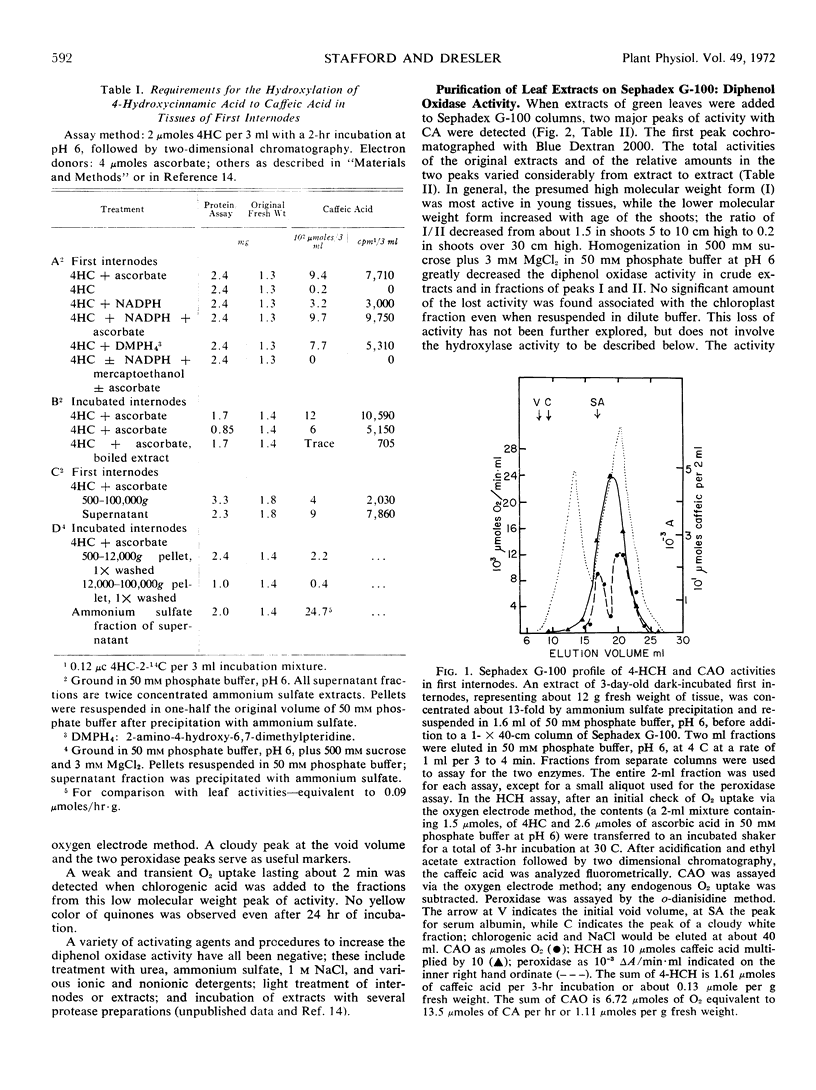Abstract
Green shoots and first internodes of Sorghum vulgare var. Wheatland milo contain three phenoloxidase activities separable by means of Sephadex G-100 gel filtration. Two of these are found only in green leaves. I, eluted at the void volume and presumably a high molecular weight form, has both monophenol and diphenol oxidase functions; II, an intermediate molecular weight form displays only a diphenol function; III, a low molecular form found only in first internodes, catalyzes the hydroxylation of 4-hydroxycinnamic acid to caffeic acid and may have a weak diphenol activity. The hydroxylase activities of peaks I and III were completely inhibited by boiling or by 1 millimolar diethyldithiocarbamate and were partially inhibited by 1 millimolar KCN. The time courses of the two monophenol activities differ in that the activity of internode tissue was linear for at least 3 hours while that of the leaf began to decrease after 15 minutes. Both O2 and a suitable electron donor were obligatory. At pH 6, ascorbic acid and 2-amino-4-hydroxy-6, 7-dimethylpteridine were the best electron donors, while NADPH was less effective. The diphenol oxidase functions of forms I and II in leaf preparations were not identical. The activity of I was less stable than that of II. While both were more active with chlorogenic acid, the ratio of activity with chlorogenic acid to that with 3,4-dihydroxyphenylalanine was less than 50 for I and greater than 50 for II.
Full text
PDF





Selected References
These references are in PubMed. This may not be the complete list of references from this article.
- Balasingam K., Ferdinand W. The purification and properties of a ribonucleoenzyme, o-diphenol oxidase, from potatoes. Biochem J. 1970 Jun;118(1):15–23. doi: 10.1042/bj1180015. [DOI] [PMC free article] [PubMed] [Google Scholar]
- Hayaishi O. Enzymic hydroxylation. Annu Rev Biochem. 1969;38:21–44. doi: 10.1146/annurev.bi.38.070169.000321. [DOI] [PubMed] [Google Scholar]
- Jolley R. L., Jr, Nelson R. M., Robb D. A. The multiple forms of mushroom tyrosinase. Structural studies on the isozymes. J Biol Chem. 1969 Jun 25;244(12):3251–3257. [PubMed] [Google Scholar]
- Jolley R. L., Jr, Robb D. A., Mason H. S. The multiple forms of mushroom tyrosinase. Association-dissociation phenomena. J Biol Chem. 1969 Mar 25;244(6):1593–1599. [PubMed] [Google Scholar]
- Patil S. S., Zucker M. Potato phenolases. Purification and properties. J Biol Chem. 1965 Oct;240(10):3938–3943. [PubMed] [Google Scholar]
- Russell D. W. The metabolism of aromatic compounds in higer plants. X. Properties of the cinnamic acid 4-hydroxylase of pea seedlings and some aspects of its metabolic and developmental control. J Biol Chem. 1971 Jun 25;246(12):3870–3878. [PubMed] [Google Scholar]
- SISLER E. C., EVANS H. J. Direct spectrophotometric determination of chlorogenic acid oxidase activity. Biochim Biophys Acta. 1958 Jun;28(3):638–639. doi: 10.1016/0006-3002(58)90532-8. [DOI] [PubMed] [Google Scholar]
- Shiman R., Akino M., Kaufman S. Solubilization and partial purification of tyrosine hydroxylase from bovine adrenal medulla. J Biol Chem. 1971 Mar 10;246(5):1330–1340. [PubMed] [Google Scholar]
- Stafford H. A., Baldy R. A monophenol oxidase activity in extracts of sorghum. Plant Physiol. 1970 Feb;45(2):215–222. doi: 10.1104/pp.45.2.215. [DOI] [PMC free article] [PubMed] [Google Scholar]
- UDENFRIEND S., CLARK C. T., AXELROD J., BRODIE B. B. Ascorbic acid in aromatic hydroxylation. I. A model system for aromatic hydroxylation. J Biol Chem. 1954 Jun;208(2):731–739. [PubMed] [Google Scholar]
- Vaughan P. F., Butt V. S. The hydroxylation of p-coumaric acid by an enzyme from leaves of spinach beet (Beta vulgaris L.). Biochem J. 1969 Jun;113(1):109–115. doi: 10.1042/bj1130109. [DOI] [PMC free article] [PubMed] [Google Scholar]


